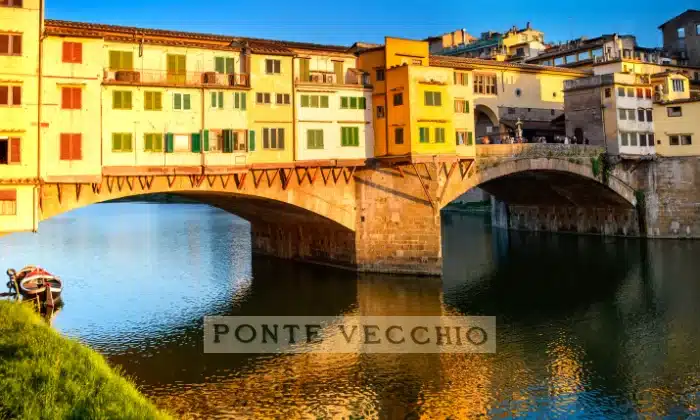Welcome to this blog on Painting Ponte Vecchio: Beauty of Florence’s Famous Bridge. The glistening waters of the River Arno have witnessed centuries of history flow through the heart of Florence, Italy. Spanning its waters almost imperceptibly is a landmark that has become intrinsically woven into the very identity of this iconic city – Ponte Vecchio. For over 850 years, this history-laden bridge has connected the bustling banks and withstood the test of time, maintaining its picturesque presence as one of the city’s most identifiable symbols.
Painting Ponte Vecchio: A Grand Portrayal of Beauty
With its unique architecture consisting of interlinking stone arches arranged in a seemingly endless sequence, Ponte Vecchio is the sole bridge in the historic center of Florence still standing atop the emerald waters of the Arno. Its illustrious past dates back to antiquated origins in the early 13th century, when the first structures were erected in its place to provide crucial connectivity between commercial districts. Through successive reconstructions, expansions and fortifications over the following generations, the bridge we know today began taking shape.
Despite facing immeasurable hardships across changing tides of war and turmoil that engulfed Tuscany, Ponte Vecchio maintained its position as the only route spanning the rushing river within the city limits. Thus, it accumulated immense strategic and economic importance that grew with time. Merchants established their shops on the bridge, showcasing various items. Goldsmiths and jewelers, in particular, thrived here for centuries, founding an enduring legacy that Ponte Vecchio is still renowned for today.
Owing to such a rich and nuanced history intertwined with the cultural progression of Florence, Ponte Vecchio attained an iconic status that transcended its municipal duties. Renowned artists frequently included its famed form and shops glistening under the Tuscan sun in their illuminating works, helping spread awareness of Florence worldwide. From sketchings and etchings to majestic paintings, the bridge became an emblematic symbol of the city’s picturesque landscapes. Even amid the ravages of World War II, stoic restoration ensured this spectacle of antiquity could inspire future generations.
So, among the elegant vistas of Italy’s famed Renaissance city, Ponte Vecchio is both a relic of medieval engineering marvels and a monument to Florence’s capacity for safeguarding cultural treasures through hardship. Its ornate arcades still sparkle with the industrious spirit that defined the city. Experience a virtual stroll across this Grand Portrayal of Beauty along Florence’s famous River Arno.
The Enduring Design of a Medieval Marvel
Still standing imperiously after centuries of traversing the Arno, Ponte Vecchio flaunts a distinctive architectural style that has perplexed engineers for ages. Its most conspicuous features originate from a strategic reconstruction effort in the 14th century, which saw the original Roman stone footbridge augmented with Gothic-style properties for enhanced durability.
Over 30 elegant arches span majestically between the stone embankments, curving vertically to disperse the force of floods away from the main structure. Many arch spans exceed 10 meters, an impressive feat of medieval engineering considering the limitations of technology back then. Closer inspection reveals skillfully carved ornamentation adorning arched openings, adding grace to the functional design.
What makes Ponte Vecchio truly unconventional, however, is the building’s integration into its 230-meter length. Foundations were constructed sturdily along the bridge sides to support multi-story edifices, appearing almost like barrack extensions. Merchants’ shops were thus established at optimum vantage points directly over the Arno! This revolutionary format maximized commerce while amalgamating residential and commercial functions innovatively.
Enduring over half a millennium of natural disasters and warfare, Ponte Vecchio stands as a resilient marvel. Its thickened central pillars, reinforced at strategic points with bastion-like buttresses, have successfully repelled countless Arno floods. Even barrages during World War 2 failed to destroy the structure, and damages were restored immaculately according to the original Gothic blueprint. Modern engineers are still baffled as to how aqueduct-like channels within the thickness of arches could divert currents harmlessly.
In summary, Ponte Vecchio flaunts an architectural fusion that has indefatigably connected Florentine banksides for ages. Its ornate arches, formidable buttressing, and ingenious water diversion tactics present an ostentatious medieval infrastructure way ahead of its time, charming visitors with its preservation of antiquity against all hurdles of time.
A Symbol of Resistance and Renaissance Spirit
Even today, Ponte Vecchio still lends immense cultural and economic importance to Florence. It has come to represent the city’s indomitable spirit against adversity. Standing defiant after narrowly surviving successive tribulations, from centuries of natural disasters to destruction attempts in World War 2, the bridge flaunts a legacy of preservation against all odds.
Its rebuilding in 1345 showcased civic will to restore livelihoods disrupted by Arno flooding, cementing Ponte Vecchio as a hub where commerce and community thrived together. Meanwhile, strategic fortifications were added to defend against invading armies, including the infamous “Corridoio Vasariano” skyway commissioned by Medici Grand Duke Cosimo I. This ensured commercial activities faced minimum disruptions despite turmoil engulfing the city.
Ponte Vecchio also gained symbolic status as a lone relic, retaining its medieval essence amid Renaissance rebirth around it. Famous artistic depictions by the likes of Michelangelo, Giorgio Vasari, and others played a significant role in proliferating the bridge’s iconic image worldwide as a prominent piece of Florence’s picturesque landscape. Their detailed renderings from different vantage points across the ages captured the dynamism of the Arno banks and contributed to cementing the city’s artistic prestige.
Even after destruction during World War 2 bombings, phoenix-like restoration over two years proved Florence’s unbending commitment to preserving cultural heritage. Reconstruction maintained original Gothic architecture while also modernizing structural integrity, reinforcing the bridge’s role as a symbol of resilience, adaptive continuity, and cultural relevance.
So, in present times, Ponte Vecchio endures as the city’s most-visited landmark, with over 2 million annual tourists. Its charming medieval shops generate millions in annual commercial revenue, retaining the original merchants’ legacy. Truly, by overcoming monumental hardships over centuries, the iconic bridge has cemented its status as a world-renowned symbol of both the city’s glorious past and indomitable Renaissance spirit.





